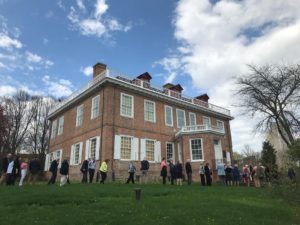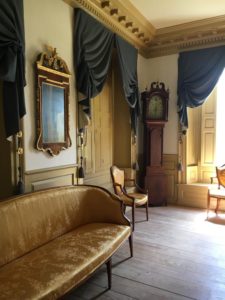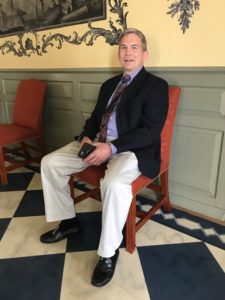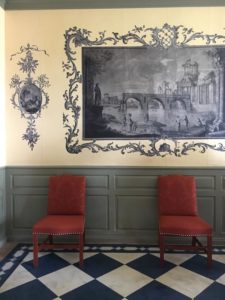The Right Time for Restorations at Schuyler Mansion
Heidi Hill, Historic Site Manager,
Schuyler Mansion State Historic Site
Sometimes timing is everything. While staff members at Schuyler Mansion planned major projects for the house’s 2017 centennial as a museum, they never expected the boost in those efforts brought by Hamilton: An American Musical. As the home of Hamilton’s in-laws, Major General Philip and Catharine van Rensselear Schuyler, the site was propelled into the limelight.
The initial wish list of conservation treatments, restoration projects, and interpretive initiatives was ambitious but attainable thanks to the staff’s quick response to this new focus on the Schuyler family. The Schuyler’s 1760s mansion in the Georgian style benefited from a new roof, the repair and painting of all the exterior wood surfaces, and restorations of the 1917 pedestrian approach and the 1817 brownstone entryway stoop and balustrade. (Figure 1). The site was also improved by a reinstalled Visitor Center and a revived garden. Inside the house, numerous projects were tackled, three of which are highlighted here:
The “Ruins of Rome” Wallpaper
This project has been a dream since the inception of the historic house as a public space in 1917. In the end, the mansion walls would have to wait for the assistance of digital photography to regain the elaborate 18th-century hand-painted paper of the “Ruins of Rome.” Examples at the Metropolitan Museum of Art in New York City and the Jeremiah Lee Mansion in Marblehead, MA, were extensively photographed, and the digital images were stitched back together to form a complete scene. The papers were printed in-house, and a master paper hanger installed the complex arrangement.
Satinwood Sofa and Chairs
The satinwood Neoclassical seating furniture chosen by the Schuylers for their Best Parlor exemplified the height of fashion after the Revolution (Figure 2). Straight from George Hepplewhite’s 1787 design catalogue, The Cabinet-Maker and Upholsterer’s Guide, these New York-made chairs even display his suggestion for the “new fashion” of accent painting with sprigs and florals to pick up the room’s color. Conservator David Bayne and two interns cleaned the dirty and over painted chairs and in-filled missing elements. A tiny swatch of original 18th-century gold silk was discovered on an arm pad. Gainsborough Silk Weavers created a close facsimile fabric that Mr. Bayne applied after rebuilding the original profile of the chair’s seat and back cushions.
Back Stools
In 2007, three rare 1760s upholstered English back stools were donated to the house by Schuyler descendants. Displayed in the mansion’s front hall, cabinetmaker Leonard Ballanca skillfully crafted three copies to create a symmetrical arrangement around the room’s perimeter. As reproductions, visitors are invited to try them, adding an interactive benefit to the project.
Trust members attending the Spring Symposium in the Upper Hudson enjoyed the fruits of these tremendous improvements at Schuyler Mansion, which will be followed by additional reconsiderations of the house’s interiors and collection.




